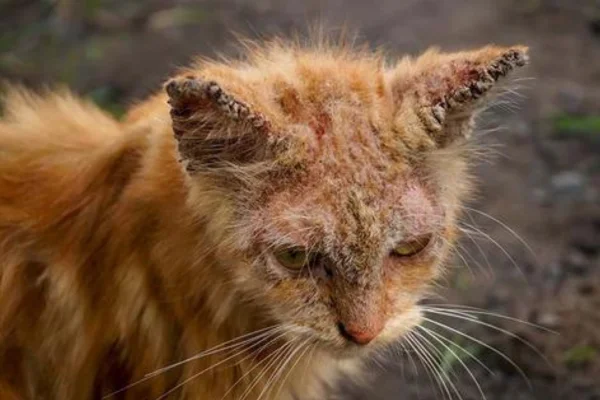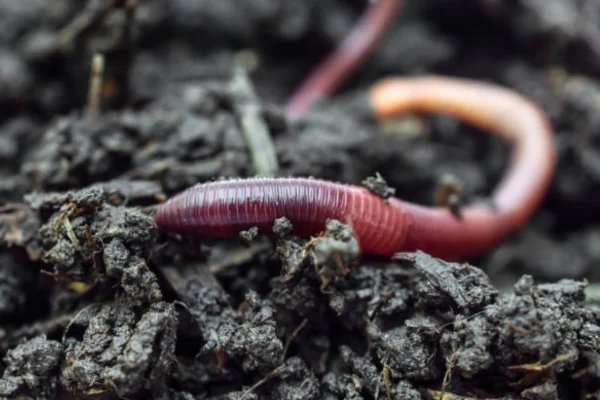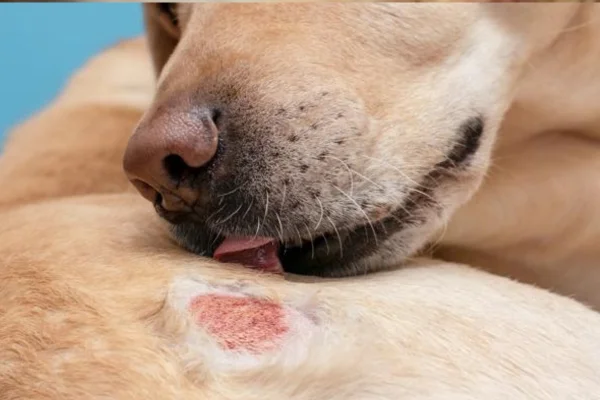Sarcoptic mange in cats
Causes, Symptoms and How to Protect Your Feline
Sarcoptic mange in cats - Sarcoptic mange, also known as scabies, is a skin disease caused by microscopic mites that can infest both animals and humans.
In cats, this condition can be particularly bothersome, causing intense itching, irritation and skin lesions.
Although not as common as in dogs, sarcoptic mange in cats requires attention and care, as it can spread quickly and have serious consequences if not treated properly.
Contents
What is Sarcoptic Mange?
Sarcoptic mange is caused by the mite Sarcoptes scabiei var. canisThe parasite penetrates the cat's skin, digging tunnels where it lays its eggs. This process triggers an intense inflammatory response, resulting in severe itching and skin lesions.
Transmission occurs mainly through direct contact with infected animals, but can also occur through contaminated objects such as beds, toys or brushes.
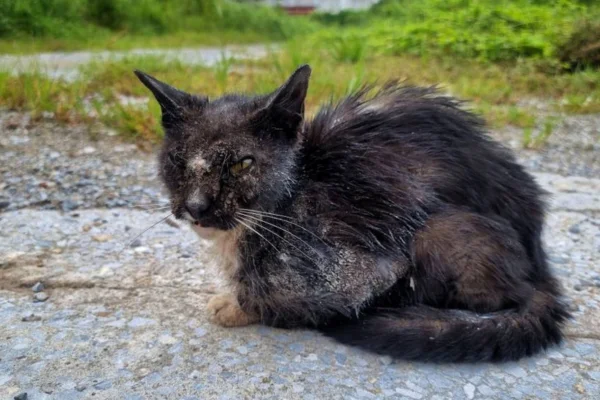
How Do Cats Catch Sarcoptic Mange?
Infection with sarcoptic mange can occur in several ways, the most common being direct contact with infected animals. Cats that live in environments with a high concentration of animals, such as shelters, streets or multi-pet households, are more susceptible. In addition, a lack of proper hygiene and a compromised immune system are factors that increase the animal's vulnerability to infestation.
Symptoms: What to Watch for in Your Cat
The symptoms of sarcoptic mange in cats can vary, but the most common signs include:
- Intense itching: One of the most characteristic symptoms is severe itching, which causes the cat to scratch incessantly, often causing sores and irritations on the skin.
- Redness and inflammation: The cat's skin may be red and swollen, especially in the areas most affected by itching, such as the ears, head, belly and armpits.
- Hair loss: As the infestation progresses, the cat may start to lose hair, especially in the areas where itching is most intense. This can result in patches of alopecia, i.e. hairless areas.
- Crust and scales on the skin: The affected areas can develop crusts, scales and a rough texture. These scabs are the result of secondary infection caused by the constant scratching and licking of the wounds.
- Behavioral changes: Because of the discomfort, the cat may become more irritable, nervous and even aggressive. They may avoid physical contact, hide more often and show signs of stress.
Diagnosis: Confirming Sarcoptic Mange
Diagnosing sarcoptic mange in cats can be challenging, as the mites are difficult to see with the naked eye. The vet usually carries out a detailed clinical examination, analyzing the animal's symptoms and history. Skin scraping is one of the most common methods of detecting the presence of mites. The material collected is examined under a microscope, where the mites can be identified.
In some cases, the diagnosis can be based on the response to treatment, especially if the skin scraping doesn't reveal mites, but the symptoms are highly suggestive of infestation.
Treatment: How to Relieve Your Cat
The treatment of sarcoptic mange in cats involves the use of drugs that eliminate the mites and relieve the symptoms. Treatment options include:
- Ivermectin: An antiparasitic administered orally or by injection that is effective against mange mites. However, it should be used with caution, especially in more sensitive breeds.
- Amitraz and Selamectin: Other topical treatment options that help eliminate mites and prevent new infestations.
- Medicinal baths: The use of specific shampoos and solutions can help relieve the symptoms and remove the mites from the cat's skin. These baths should be administered under veterinary supervision to avoid further irritation to the animal's skin.
- Antibiotics: In cases where there are secondary infections due to the lesions, the use of antibiotics may be necessary to treat these complications.
- Anti-inflammatories and Corticoids: To relieve inflammation and intense itching, the vet may prescribe anti-inflammatory drugs or corticosteroids.
Prevention: How to Avoid Infestation
Prevention is always the best medicine, and this also applies to sarcoptic mange in cats. Here are some tips to protect your feline:
- Proper hygiene: Keep your cat's living environment clean. Wash their bedding, toys and other items regularly.
- Infestation control: If you have other animals at home, make sure they all receive preventive treatment against parasites, especially if one of them shows symptoms of mange.
- Regular visits to the vet: Regular check-ups help to identify health problems early on, allowing effective treatment before the condition worsens.
- Avoid contact with infected animals: If you know that an animal is infected, keep your cat away until the sick animal is treated and free of mites.
Is Sarcoptic Mange Contagious to Humans?
Yes, sarcoptic mange is a zoonosis, which means it can be transmitted from animals to humans. Although the mite prefers animal hosts, it can temporarily infest human skin, causing itching, redness and small rashes. However, as the mite cannot complete its life cycle in humans, the symptoms usually disappear on their own after a few days.
How to Protect the Family
To prevent the transmission of sarcoptic mange to humans, follow these precautions:
- Rigorous cleaning: Wash all bedding, clothing and items that may have come into contact with the infected cat in hot water.
- Avoid Direct Contact: While your cat is being treated, avoid prolonged direct contact with it. Wash your hands after touching it and wear gloves if necessary.
- Simultaneous Treatment of All Animals: If you have other animals at home, treat all of them, even if they don't show symptoms, to avoid re-infestation.
Emotional Impact and Coping with Sarcoptic Mange
Discovering that your cat has sarcoptic mange can be stressful for both the animal and the owner. Seeing your feline companion suffering from intense itching and skin lesions is distressing, and the treatment process can be challenging.
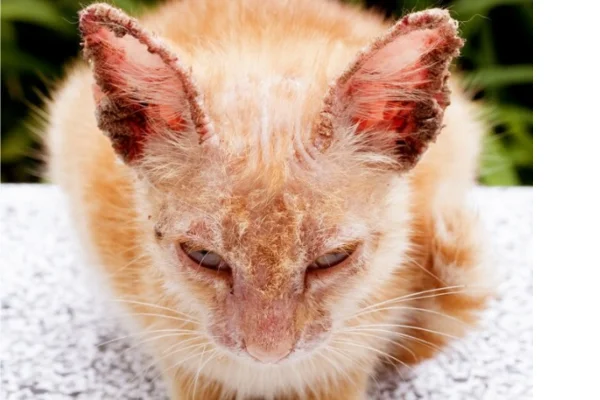
Care and Affection During Treatment
During treatment, it is important that the cat receives lots of affection and attention. Create a peaceful environment where they feel safe. Adequate nutrition and hydration are also essential to aid recovery. Remember that stress can worsen symptoms, so maintain a calm and predictable routine for your feline.
When to seek professional help
If you suspect that your cat may have sarcoptic mange, don't hesitate to go to the vet. The sooner treatment begins, the faster your cat will recover. What's more, a professional will be able to provide specific guidance for your pet's case, ensuring that it receives the best possible care.
Conclusion: Caring for Your Cat
Sarcoptic mange in cats is a condition that requires immediate attention and appropriate treatment. Although it can be an uncomfortable experience for both the animal and the guardian, with the right care, it is possible to overcome the infestation and ensure that the cat returns to a healthy and happy life.
Remember that prevention is the key, and maintaining a routine of care for your feline can prevent many problems in the future. With love, patience and the right measures, you'll be helping your cat to overcome this uncomfortable condition and regain its quality of life.
Thank you for visiting us and check out our other work
https://vettopbr.com/cachorros/

